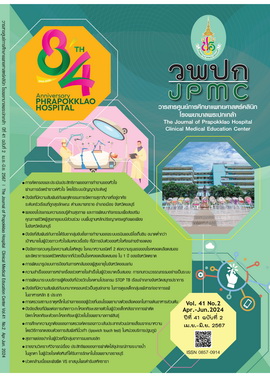การตรวจสถานะธาตุเหล็กในร่างกายของผู้ป่วยที่นอนโรงพยาบาลด้วยเลือดออกในทางเดินอาหารส่วนต้น
Main Article Content
บทคัดย่อ
ที่มาของปัญหา: ในปัจจุบันยังขาดข้อมูลในการตรวจสถานะธาตุเหล็กและความชุกของโรคโลหิตจางจากขาดธาตุเหล็กในผู้ป่วยเลือดออกในทางเดินอาหารส่วนต้น
วัตถุประสงค์ ศึกษาการตรวจสถานะธาตุเหล็กและความชุกของโรคโลหิตจางจากขาดธาตุเหล็ก รวมถึงปัจจัยที่ส่งผลให้ผู้ป่วยเกิดโรคโลหิตจางจากขาดธาตุเหล็กในผู้ป่วยเลือดออกในทางเดินอาหารส่วนต้นเฉียบพลัน
วิธีการศึกษา: ศึกษาข้อมูลย้อนหลังจากเวชระเบียนผู้ป่วยในที่นอนโรงพยาบาลด้วยเลือดออกในทางเดินอาหารส่วนต้นและมีโลหิตจางร่วมด้วย ระหว่าง พ.ศ. 2559-2562
ผลการศึกษา: จากผู้ป่วย 867 คน มี 180 คน (ร้อยละ 20.8) ที่ได้รับการตรวจสถานะธาตุเหล็ก ในกลุ่มผู้ป่วยนี้ 108 คน (ร้อยละ 60.0) มีโรคโลหิตจางจากขาดธาตุเหล็ก โดยปัจจัยที่ทำให้มีการส่งตรวจสถานะธาตุเหล็ก ได้แก่ โรคกล้ามเนื้อหัวใจขาดเลือด (aOR 3.88, p=0.001), การใช้ยาต้านอักเสบชนิดที่ไม่ใช่สเตียรอยด์ (aOR 1.56, p=0.03), การใช้ยาสมุนไพร (aOR 2.84; p=0.01), และเม็ดเลือดแดงขนาดเล็ก (aOR 1.52; p=0.03) ส่วนปัจจัยที่ทำให้ไม่มีการส่งตรวจ ได้แก่ อายุที่มากขึ้น (aOR เพิ่มขึ้น 0.984 สำหรับทุกๆ 1 ปี, p=0.01), เลือดออกจากเส้นเลือดดำโป่งพอง (aOR 0.14, p<0.001) และ AIMS65 score มากกว่า 2 คะแนน (aOR 0.69, p=0.002) นอกจากนี้พบว่า เพศหญิง (aOR 2.69, p=0.05), และเม็ดเลือดแดงขนาดเล็ก (aOR 2.00, p=0.04) เป็นปัจจัยที่มีผลต่อการเป็นโรคโลหิตจางจากขาดธาตุเหล็ก แต่โรคเบาหวานเป็นปัจจัยที่ป้องกันการเกิดโรค (aOR 0.32, p=0.001).
สรุป: การตรวจสถานะธาตุเหล็กในผู้ป่วยเลือดออกในทางเดินอาหารส่วนต้นและมีโลหิตจางยังน้อย ในขณะที่พบโรคโลหิตจากจากขาดธาตุเหล็กมากในผู้ป่วยที่ได้รับการตรวจ งานวิจัยนี้ชี้ให้เห็นถึงความสำคัญในการตรวจสถานะธาตุเหล็กและปัจจัยของการเกิดโรคโลหิตจากการขาดธาตุเหล็กเพื่อเป็นแนวทางในการรักษาโลหิตจางในผู้ป่วยผู้ป่วยเลือดออกในทางเดินอาหารส่วนต้น
ClinicalTrials.gov Identifier, NCT06299007
Article Details

This work is licensed under a Creative Commons Attribution-NonCommercial-NoDerivatives 4.0 International License.
References
Cotter J, Baldaia C, Ferreira M, Macedo G, Pedroto I. Diagnosis and treatment of iron-deficiency anemia in gastrointestinal bleeding: a systematic review. World J Gastroenterol 2020;26:7242-57.
Planella de Rubinat M, Teixidó Amorós M, Ballester Clau R, Trujillano Cabello J, Ibarz Escuer M, Reñé Espinet JM. Incidence and predictive factors of iron deficiency anemia after acute non-variceal upper gastrointestinal bleeding without portal hypertension. Gastroenterol Hepatol 2015;38:525-33.
Kulnigg S, Stoinov S, Simanenkov V, Dudar LV, Karnafel W, Garcia LC, et al. A novel intravenous iron formulation for treatment of anemia in inflammatory bowel disease: the ferric carboxymaltose (FERINJECT) randomized controlled trial. Am J Gastroenterol 2008;103:1182-92.
Rockall TA, Logan RF, Devlin HB, Northfield TC. Risk assessment after acute upper gastrointestinal haemorrhage. Gut 1996;38:316-21.
Stein J, Connor S, Virgin G, Ong DE, Pereyra L. Anemia and iron deficiency in gastrointestinal and liver conditions. World J Gastroenterol 2016;22:7908-25.
Mak LY, Lau CW, Hui YT, Ng C, Shan E, Li MK, et al. Joint recommendations on management of anaemia in patients with gastrointestinal bleeding in Hong Kong. Hong Kong Med J 2018;24:416-22.
Laine L, Barkun AN, Saltzman JR, Martel M, Leontiadis GI. ACG clinical guideline: upper gastrointestinal and ulcer bleeding. Am J Gastroenterol 2021;116:899-917.
Barkun AN, Almadi M, Kuipers EJ, Laine L, Sung J, Tse F, et al. Management of nonvariceal upper gastrointestinal bleeding: guideline recommendations from the international consensus group. Ann Intern Med 2019;171:805-22.
Chang A, Ouejiaraphant C, Akarapatima K, Rattanasupa A, Prachayakul V. Prospective comparison of the AIMS65 score, Glasgow-Blatchford score, and Rockall score for predicting clinical outcomes in patients with variceal and nonvariceal upper gastrointestinal bleeding. Clin Endosc 2021;54:211-21.
Blatchford O, Murray WR, Blatchford M. A risk score to predict need for treatment for upper-gastrointestinal haemorrhage. Lancet 2000;356:1318-21.
Saltzman JR, Tabak YP, Hyett BH, Sun X, Travis AC, Johannes RS. A simple risk score accurately predicts in-hospital mortality, length of stay, and cost in acute upper GI bleeding. Gastrointest Endosc 2011;74:1215-24.
Lopez A, Cacoub P, Macdougall IC, Peyrin-Biroulet L. Iron deficiency anaemia. Lancet 2016;387:907-16.
El-Halabi MM, Green MS, Jones C, Salyers WJ Jr. Under-diagnosing and under-treating iron deficiency in hospitalized patients with gastrointestinal bleeding. World J Gastrointest Pharmacol Ther 2016;7:139-44.
Chang A, Rugivarodom M, Pungpipattrakul N, Akarapatima K, Suwanno K, Rattanasupar A, et al. Role of oral iron supplementation for anemia secondary to acute nonvariceal upper gastrointestinal bleeding: a randomized controlled trial. J Gastroenterol Hepatol 2023;38:1283-91.
Bager P, Dahlerup JF. Randomised clinical trial: oral vs. intravenous iron after upper gastrointestinal haemorrhage--a placebo-controlled study. Aliment Pharmacol Ther 2014;39:176-87.
Mc Quilten ZK, Thao LTP, Pasricha SR, Artz AS, Bailey M, Chan AT, et al. Effect of low-dose aspirin versus placebo on incidence of anemia in the elderly: a secondary analysis of the aspirin in reducing events in the elderly trial. Ann Intern Med 2023;176:913-21.
Tielleman T, Bujanda D, Cryer B. epidemiology and risk factors for upper gastrointestinal bleeding. Gastrointest Endosc Clin N Am 2015;25:415-28.
Ahsberg K, Höglund P, Kim WH, von Holstein CS. Impact of aspirin, NSAIDs, warfarin, corticosteroids and SSRIs on the site and outcome of non-variceal upper and lower gastrointestinal bleeding. Scand J Gastroenterol 2010;45:1404-15.
Lee MW, Katz PO. Nonsteroidal antiinflammatory drugs, anticoagulation, and upper gastrointestinal bleeding. Clin Geriatr Med 2021;37:31-42.
Tomasević R, Gluvić Z, Mijač D,Sokić-Milutinović A, Lukić S, Milosavljević T. Anemia as a problem: GEH approach. Dig Dis 2022;40:133-41.
Johnson-Wimbley TD, Graham DY. Diagnosis and management of iron deficiency anemia in the 21st century. Therap Adv Gastroenterol 2011;4:177-84.
Joosten E, Dereymaeker L, Pelemans W, Hiele M. Significance of a low serum ferritin level in elderly in-patients. Postgrad Med J 1993;69:397-400.
Thandassery RB, Sharma M, John AK, Al-Ejji KM, Wani H, Sultan K, et al. Clinical application of AIMS65 scores to predict outcomes in patients with upper gastrointestinal hemorrhage. Clin Endosc 2015;48:380-4.
Saito H. Metabolism of iron stores. Nagoya J Med Sci 2014;76:235-54.
Soliman AT, De Sanctis V, Yassin M, Soliman N. Iron deficiency anemia and glucose metabolism. Acta Biomed 2017;88:112-8.
Pradeepa R, Shreya L, Anjana RM, Jebarani S, Kamal Raj N, Kumar MS, et al. Frequency of iron deficiency anemia in type 2 diabetes-Insights from tertiary diabetes care centres across India. Diabetes Metab Syndr [Internet]. 2022 [cited 2023 Nov 15];16(11):102632. Available from: https://www.sciencedirect.com/science/article/abs/pii/S1871402122002466?via%3Dihub
